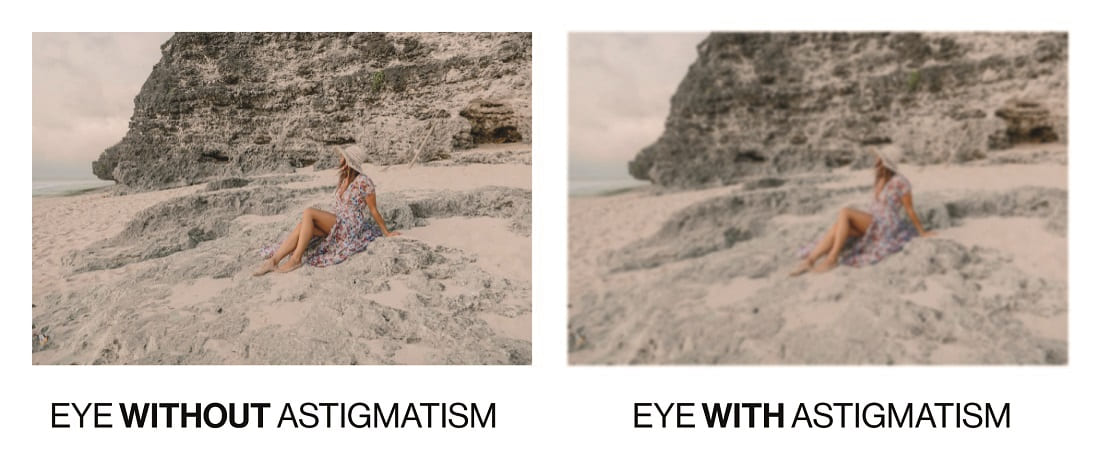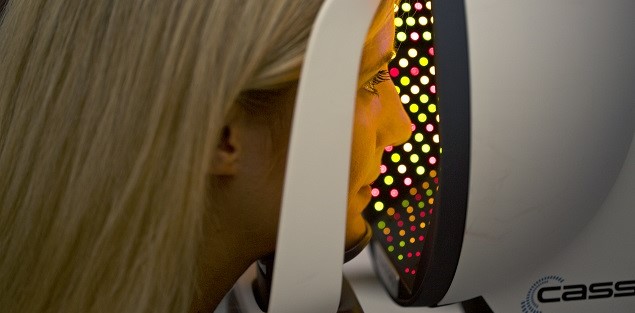Refractive surgery / Astigmatism
What is astigmatism?
When talking about the definition of astigmatism , it is important to stress that it is a common refractive defect, not a disease or a visual health issue. An eye has astigmatism when the cornea has the same curvature on all its axes, meaning that light is focused in more than one place either in front or behind the retina, and vision will be blurry both close up and at a distance.
The cornea will be elliptical or oval in shape. In most cases astigmatism is hereditary, which means that you are born with this refractive error even though the symptoms won’t develop until years later. Astigmatism is measured in dioptres (negative sign) between degrees of 0 and 180º.
Around 20-40% of the population suffers from astigmatism and it may also occur in combination with myopia or hyperopia. In those cases it is referred to as myopic astigmatism or hyperopic astigmatism, respectively.

Myopic astigmatism
Myopic astigmatism occurs in combination with myopia, meaning that one or both of the eye’s main axes focus as myopic. Both myopia and astigmatism are refractive error caused by deformation of the cornea. Myopic astigmatism is corrected with glasses or laser refractive surgery. It may also be treated by implanting intraocular toric lenses (ICL).
Hyperopic astigmatism
Hyperopic astigmatism occurs in combination with hyperopia. In this case, if both eyes focus as hyperopic, they focus at different degrees.
This type of refractive error causes blurry vision at all distances, but primarily with objects up close. It can be corrected with glasses or, as with the previous case, with refractive surgery or intraocular toric lenses (ICL).
Causes of astigmatism
Astigmatism is a type of refractive error that causes distorted vision, as light rays are not refracted correctly due to the irregular curvature of the cornea.
The condition of this structure may be genetically, determined, caused by an injury to the cornea or certain surgical procedures, such as a corneal transplant or cataract or lens surgery, for example.
It may also occur due to an illness or existing pressure behind the eye that affects other nerves, although the cornea tends to be responsible in most cases. As such, although we still do not know exactly why it occurs, the probability of developing astigmatism is hereditary..
This refractive error usually remains stable throughout your life, except in very rare cases. Furthermore, it is just a myth that you can develop or worsen astigmatism as a result of activities such as reading in dimly lit rooms or sitting too close to the television.
Symptoms of astigmatism
Symptoms may vary according to age, the type of astigmatism and even the prescription. The higher the prescription, the more distorted images will appear to the patient.
Therefore, although mild astigmatism does not usually produce symptoms, patients with astigmatism will notice blurred vision, both near and far, although most of them will not be aware that they suffer from this refractive defect.
They may be able to make out small objects or details at all distances. This is due to the effort that the eye makes to bring the images into focus.
Furthermore, if the eye is also hyperopic, patients may suffer from eye pain or occasional headaches, particularly after reading. Other possible symptoms are eye strain, red eyes, itching and difficulty switching between near and far vision, and vice versa.
If I have astigmatism, how is it possible that I don’t notice any symptoms?
This is due to the accommodation of our eye, which is our ability to bring things into focus. This refers to the changes the crystalline lens makes between near and far vision, which relies on elasticity and our ciliary muscles, a process called accommodation. When someone suffers from a refractive error, the eye attempts to mitigate the error through accommodation.
However, in patients with myopia or myopia combined with astigmatism, accommodating distance vision only worsens the image, whereas in patients who suffer from hyperopia with or without astigmatism it is improved, as long as it is only mild.
The same applies to an eye with astigmatism, where the cornea is uneven and the accommodation depends on the ciliary muscles contracting asymmetrically at different axes.
Types of astigmatism
Through a comprehensive eye examination, the specialist can identify what kind of astigmatism you have:
Regular or irregular
Regular astigmatism
In this case the two main axes are at right angles to each other. This is the most common type of astigmatism and can be corrected with contact lenses.
Irregular astigmatism
With this type, the two main axes are not at right angles to each other. This may be caused by keratoconus and is difficult to correct with contact lenses.
Simple or compound
Simple astigmatism
One of the focal lines is on the retina, whereas the other is behind or in front of it. As such, one axis is emmetropic (no prescription) while the other is not. This can be classified as simple myopic astigmatism (the vertical axis is myopic) and simple hyperopic astigmatism (the horizontal axis is hyperopic).
Compound astigmatism
Neither of the two focal lines are on the retina and none of the axes are emmetropic. This may be compound myopic astigmatism (both axes are myopic), compound hyperopic astigmatism (both axes are hyperopic) or mixed astigmatism (one axis is myopic and the other is hyperopic).
Direct or inverse
Direct astigmatism
This is where the highest refraction is on the vertical axis and the lowest is on the horizontal axis.
Inverse astigmatism
This is where the highest refraction is on the horizontal axis and the lowest is on the vertical axis.
Oblique astigmatism
When the axis with the highest prescription is positioned obliquely.
Treating astigmatism
Astigmatism cannot be cured, but it can be corrected through the use of glasses or contact lenses.
However, there are a various surgical techniques, encompassed by the global term refractive laser surgery which can be used to treat myopia and astigmatism. It is a simple, fast and painless operation that at Oftalvist we perform using a femtosecond laser platform, for a 100% laser procedure that is as safe as possible. It is currently the most advanced laser technology that exists.
Another technique that provides great results is intraocular toric lens, implants, which are designed specifically for permanently correcting astigmatism.
The properties of these lenses enable us to correct the asymmetry of an eye and improve both near and far vision, when a patient is not a suitable candidate for Lasik surgery:
→ Manufactured with a special curvature customised for each eye.
→ They need to be positioned very carefully and precisely in each eye.
→ They provide patients with fantastic visual acuity.
It will be the ophthalmologist who will opt for one type of surgery or another, after having performed a comprehensive examination of the patient’s eye.
In cases of infantile astigmatism, the most common treatment is prescription glasses.
Preoperative tests for astigmatism surgery
✓ Measurement of intraocular pressure.
✓ Test for visual acuity and prescription.
✓ Examination of the anterior and posterior segments of the eye.
✓ Corneal topography.
✓ Aberrometry.
✓ Pachymetry.
✓ Laser biometry.
Preventing astigmatism
Astigmatism is a refractive error that cannot be prevented, but in most cases it is operable. However, to prevent it occurring, specialists recommend avoiding rubbing the eyes a lot and having check-ups on an annual basis, particularly for children, as this may help to prevent it from developing further. Below is some advice to follow:
→ Only watch television with the lights turned on and at a considerable distance, approximately 3 metres away.
→ Use screens or electronic devices with low radiation levels.
→ Take short breaks or blink regularly when working with a computer.
→ If you notice any eye pain or strain, it is a good idea to massage the temples in circular movements.
Astigmatism in children
During childhood, if astigmatism is not corrected patients may develop amblyopia, or lazy eye.
Infantile astigmatism is one of the most common vision problems that may occur in children. It develops because the cornea, instead of being round, is flattened at the poles, which is why it appears irregular along the main axes, as with adults.
In most cases, children are already born with this disorder as it is generally congenital. As such, parents with astigmatism should pay particular attention to their children, as they will also be susceptible to it and, as we mentioned above, it may trigger other disorders, such as lazy eye.
How is astigmatism treated in children?
It is usually corrected by using glasses with toric or cylindrical lenses to mitigate their poor vision. Once the child gets older, they may choose to wear contact lenses; and when they reach adulthood, they may consider refractive surgery.




